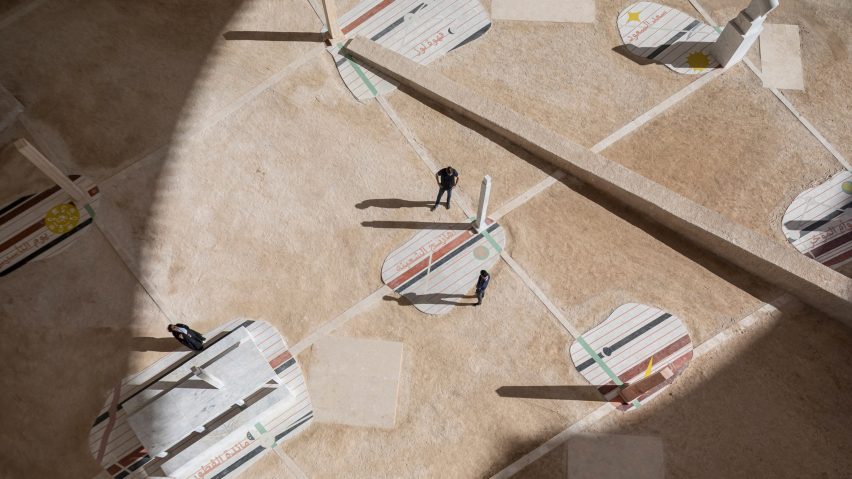Kuwait- and Bahrain-based Civil Architecture has created a sundial at the Islamic Arts Biennale in Jeddah, Saudi Arabia, that aims to question our relationship with time.
Civil Architecture founders Hamed Bukhamseen and Ali Karimi installed the fragmented sundial within the "desert landscape" created as the backdrop for the biennale by architecture studio OMA.
They designed the structure to draw attention to our changing relationship with time.
"It's an antidote to the fractured notion of time," Bukhamseen and Karimi told Dezeen. "Beyond the four seasons and the work week, time has become an elusive quality."
"This quality is even further fractured in the context of the pandemic, and the eternal present that was experienced for two years in domestic settings," they continued.
"Re-envisioning the sundial as a way of watching the world allows us to rethink how we schedule our week, month, year and how we break down our calendar."
The installation consists of numerous obelisks, placed on a grid within the desert-like landscape, that will each act as hour markers.
Each of the structures stands on paved plinths that act as "fragments of a calendar" and are painted with events that will take place during the day and the biennale.
"The calendar and the plazas highlight various cultural and lunar events, like the beginning of Ramadan, rose planting season, in addition to the tides and moon phases," said Bukhamseen and Karimi.
"So markers not only tell you what time or day it is, they also place that moment within a wider context," they continued.
"It's not about telling you what time it is, but breaking the notion of atomic time – the sun never hits the same place, the tides and moon do not occur at the same moment."
Unusually, the sundial was installed under a canopy with an oculus within the structure creating a focused beam of light that tracks around the installation.
Under the direction of artistic director Sumayya Vally, the biennale is taking place within the Western Hajj Terminal at King Abdulaziz International Airport, which was designed by US studio Skidmore Owings & Merrill in the early 1980s.
"It's the simplest of architectural interventions: placing markers or inscriptions, but doing so allows the building to read less as a shading device and more as an active tool for understanding the passage of time," said Bukhamseen and Karimi.
"We liked the idea that the intervention reclaims the building, changing it from airport terminal to a device within a larger lineage of astronomical buildings and observatories."
Civil Architecture also created the installation as a comment on the post-pandemic world and hope that people will reflect on how they choose to spend their time.
"The sundial is on one hand a non-event, it is pure celestial mechanics," said Bukhamseen and Karimi. "On the other hand, it is an event every hour and every day of the biennale."
"We felt it was important, in both a world following two years without events, and now with a deluge of events – to consider what is even worth adding to one's calendar," they added.
Also at the Islamic Arts Biennale, which was organised by the Diriyah Biennale Foundation, Yasmeen Lari created trio of bamboo pop-up mosques, while Studio Bound created aimed to communicate the idea that all of Mecca can be considered a mosque.
The photography is by Laurian Ghinitoiu, unless stated.
The Islamic Arts Biennale takes place in Jeddah from 23 January until 23 April 2023. See Dezeen Events Guide for an up-to-date list of architecture and design events taking place around the world.

